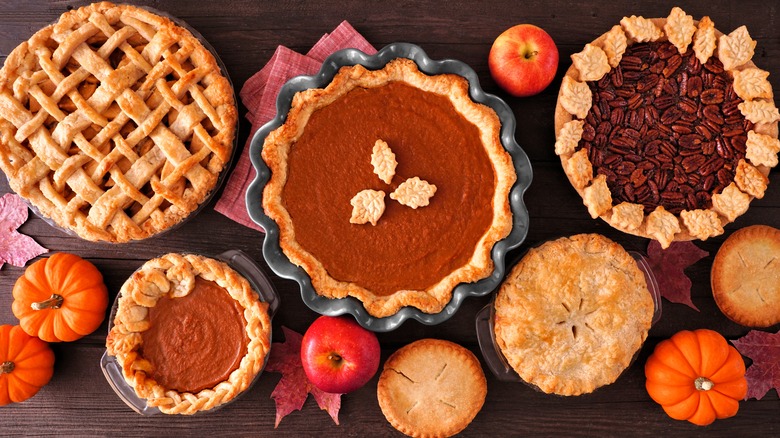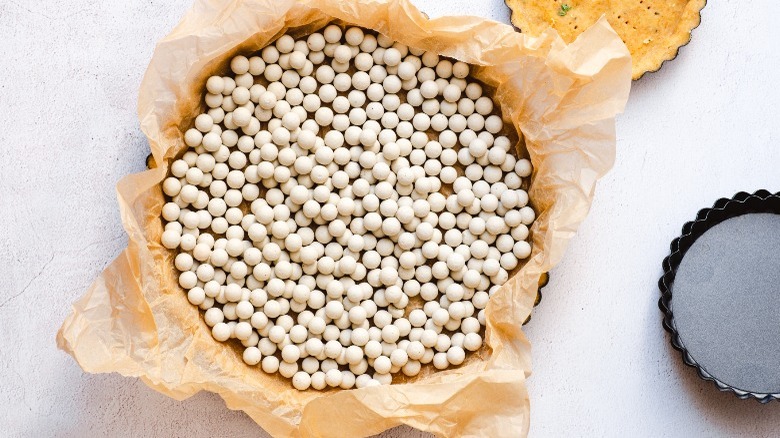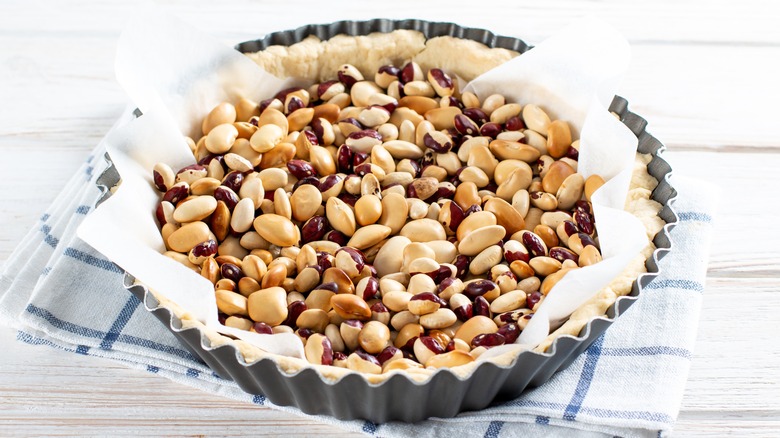Why It's Essential To Weigh Down Your Pie Crust When Blind Baking
Pie is one of those desserts that always seems like a good idea, its buttery crust contrasting with sweet fillings ranging from decadent peanut butter mousse to classic pecan to irresistible banana pudding. Delicious at any time of day — whether that's post-dinner or accompanying a morning cup of coffee — pie is a natural option to pick up from your favorite local bakery. But for experienced bakers, or those ready and willing to take on the sometimes-formidable challenge of making a pie from scratch, carefully assembling your favorite recipe at home can be a fun (and hopefully tasty) task.
Making a delicious pie at home gets easier with time and practice, but for less expert bakers, pie-baking mistakes can seem to crop up at every step, especially when it comes to preparing the crust. A pie's crust should ideally turn out flaky, golden brown, and crisp, but it can seem like just looking at pie dough wrong can cause it to emerge from the oven under-baked, soggy, or tough (via Bon Appétit). Using cold ingredients, working the dough only gently, and baking pie in a glass dish all help create a stellar pie crust, but if you're not using pie weights when you blind bake a crust, you're going to want to employ the technique the next time you bake.
Pie weights help a crust keep its shape while baking
If you've baked your fair share of pies at home, you've no doubt noticed that some types call for "blind baking" the crust before the filling goes in. This technique is generally used in two instances, according to King Arthur Baking: One, for pies whose filling isn't cooked at all, like icebox pies, so the filling can simply be poured into an already baked and crisp crust; And two, for delicate cream or custard fillings that would likely separate or curdle in the oven when baked for the full baking time the crust requires.
But blind baking doesn't simply entail rolling out your pie crust, transferring it to your pie plate, and sticking it in the oven. For best results, KitchenAid explains that pie weights should be used in order to preserve the shape, size, and structure of the crust. The outlet notes that when exposed to the heat of the oven, the steam escaping from the crust — caused by the moisture content of the butter and any liquids added — will cause the crust to bubble in certain spots, or else slip and slump in the pan.
Normally, a pie's filling will keep the crust weighted down, but in the absence of a filling, pie weights must be used to keep everything neat and in place.
Ways to weight your crust
If you've never heard of pie weights, you might not know that there are commercial versions you can purchase, which are typically made out of ceramic or aluminum (via Web Restaurant Store). But, as noted by MasterClass, it's really not necessary to buy pie weights: Rather, you can use dried beans, rice, or even copper pennies (just note that any beans or grains used for weighting pie crust should be reserved for that purpose only, as they won't cook up normally after being baked). Even plain granulated sugar makes an excellent pie weight, according to Southern Living, and what's great about that is it's a cheap method, too.
To weight a pie crust, first line the prepared crust with a sheet of parchment paper or aluminum foil, and then pour in your weight of choice, making sure to use a quantity that will effectively hold down the bottom and sides of the crust, explains MasterClass. Then, follow the recipe's instructions for blind baking. If your pie's filling does not need to bake, cool the blind baked crust completely before filling it to avoid any sogginess (via Sally's Baking Recipes). If the pie filling needs to bake, such as in the case of a pumpkin pie or an egg filling for quiche, you can partially bake the crust before filling it and sticking it back in the oven to bake through.


